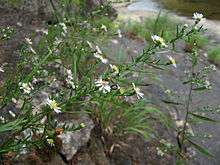Symphyotrichum dumosum
Symphyotrichum dumosum, common names rice button aster[2] or bushy aster,[3] is an herbaceous plant in the aster family. It is native to a widespread area across the eastern half of the United States from Texas to Florida to Maine to Wisconsin. It is also native to New Brunswick and Ontario, and is cultivated in other places.[4]
| Symphyotrichum dumosum | |
|---|---|
 | |
| Scientific classification | |
| Kingdom: | Plantae |
| Clade: | Tracheophytes |
| Clade: | Angiosperms |
| Clade: | Eudicots |
| Clade: | Asterids |
| Order: | Asterales |
| Family: | Asteraceae |
| Tribe: | Astereae |
| Genus: | Symphyotrichum |
| Species: | S. dumosum |
| Binomial name | |
| Symphyotrichum dumosum (L.) G.L.Nesom | |
| Synonyms[1] | |
| |
Symphyotrichum dumosum is a perennial herb up to 100 cm (40 in) tall. Heads are born in paniculiform arrays. Ray flowers are blue, pink, purple or white; disc flowers pale yellow, turning pink with age.[5]
This species was long known as Aster dumosus before it was moved into its current genus due to a phylogenetic analysis. The genus Aster has been narrowed considerably in scope in recent years, due to new information about the relationships of the species in the group.
Varieties
The following 5 varieties are recognized:[1]
- Symphyotrichum dumosum var. dumosum
- Symphyotrichum dumosum var. gracilipes (Wiegand) G.L.Nesom
- Symphyotrichum dumosum var. pergracile (Wiegand) G.L.Nesom
- Symphyotrichum dumosum var. strictior (Torr. & A.Gray) G.L.Nesom
- Symphyotrichum dumosum var. subulifolium (Torr. & A.Gray) G.L.Nesom
Gallery
_(6435495559).jpg) Detail of flowering head
Detail of flowering head
References
- "Symphyotrichum dumosum". The Global Compositae Checklist (GCC) – via The Plant List.
- "Symphyotrichum dumosum". Natural Resources Conservation Service PLANTS Database. USDA. Retrieved 6 December 2015.
- "BSBI List 2007". Botanical Society of Britain and Ireland. Archived from the original (xls) on 2015-01-25. Retrieved 2014-10-17.
- Brouillet, Luc; Semple, John C.; Allen, Geraldine A.; Chambers, Kenton L.; Sundberg, Scott D. (2006). "Symphyotrichum dumosum". In Flora of North America Editorial Committee (ed.). Flora of North America North of Mexico (FNA). 20. New York and Oxford – via eFloras.org, Missouri Botanical Garden, St. Louis, MO & Harvard University Herbaria, Cambridge, MA.
- G. L. Nesom, Phytologia. 77: 280. 1995.